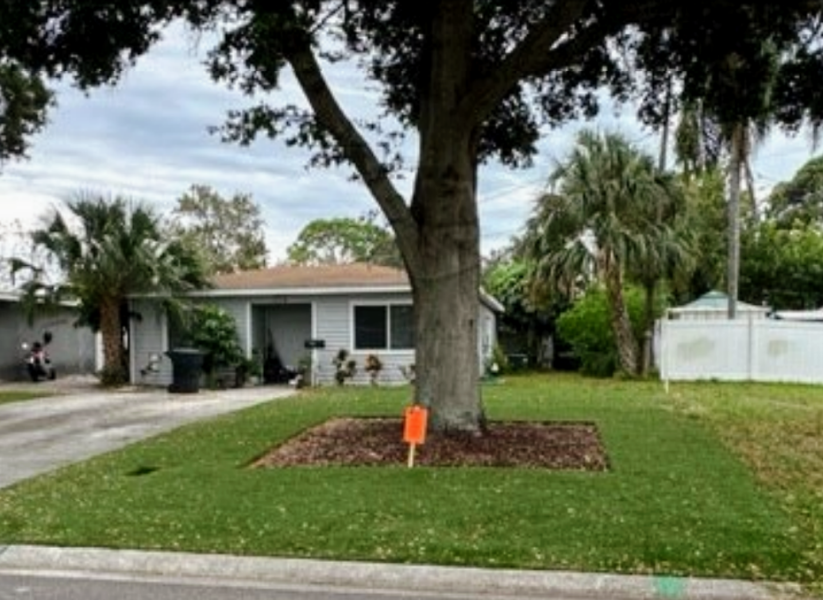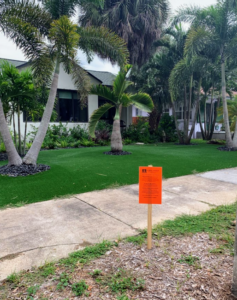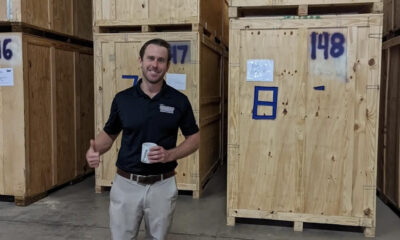Thrive
Should St. Pete allow turf yards?

Whether they have difficulty maintaining yards, or concerns regarding harmful nutrients found in fertilizers, homeowners increasingly want to eschew grass and implement synthetic turf, shells or rock.
However, St. Petersburg administrators consider those materials impervious, and harmful to stormwater systems, and only permit yards to feature a small percentage of nonpermeable landscaped green space. City council members, business leaders and zoning, engineering and stormwater officials discussed expanding grass-alternative allowances at a recent committee meeting.
Councilmember Copley Gerdes requested the business item due to confusion and concerns over what is permissible.
“This couple can no longer mow their yard,” said Gerdes, referring to a home in west St. Pete’s District 1, at the May 11 meeting. “And they would like to have a green yard. I just don’t think that’s unreasonable.”
City regulations state that “yards shall be maintained as permeable landscaped vegetative green space with the exception of driveways, walks, patios and similar paved areas … which areas combined shall not exceed 25% of the required yard area for corner lots and 45% of the required for inside lots.”
City code also prohibits using any artificial turf, shells or pavers on the right of way because the material will eventually clog and impede rainwater from flowing into the ground. Claude Tankersley, public works administrator, relayed that residents following the regulations could still pay higher utility rates due to the increased impervious area.
In addition, zoning manager Corey Malyszka noted that driveways and sidewalks count towards the 25% and 45% limits. St. Petersburg code enforcement has issued 12 citations in the past two years for installing artificial turf, with eight including the property and right of way.
Councilmember Brandi Gabbard called the regulations “incredibly confusing” and said constituents often ask about using shells in their yard.
“They look at it as, we live in Florida,” Gabbard added. “They put them in their yard, they don’t realize that they’re in the right of way or they’ve maxed out the 45%, and now we go and cite them.
“I’ve also had those same residents … that will then go and survey some city property and see that we have shells, and they want to say, ‘But you guys are doing it.'”
She noted that maintaining a lawn without using pesticides and fertilizers – which feed red tide outbreaks – is challenging. A lack of grass also leads to soil and sediment erosion.

Another example of an after-the-fact variance request that was denied. Screengrab.
Tommy Cassidy, a local business owner and member of the National Synthetic Turf Council, noted that water-challenged cities like Las Vegas are pushing residents to use faux grass. He and Gerdes relayed that the Tampa officials are reviewing related code enforcement and permitting processes.
Cassidy said new base materials and turf mitigate heat radiation aspects. However, Liz Abernethy, planning and development services director, referenced a Stetson University report highlighting how “widespread use in residential landscaping could exacerbate the heat island effect and require more energy to cool homes.”
Tankersley explained that turf allows water to percolate through if it is properly maintained. He said the city’s primary concern is that it reacts to dirt and grime like an air filter and becomes clogged and impermeable over time.
“The bottom line for us is that we don’t see artificial turf as a pervious surface,” Tankersley added. “It will form an impervious surface and eventually add more to our stormwater issues.”
Brejesh Prayman, director of engineering, said shells and rocks end up in roadways, block drainage systems, create maintenance issues and become slip hazards to pedestrians using sidewalks. Like Tankersley, he said it would take a substantial compliance and monitoring effort to ensure residents properly maintained alternative landscaping.
Councilmember Richie Floyd called the discussion and backup materials “fascinating.” While he supported his colleagues’ request for more information, Floyd said creating more avenues for stormwater to reach treatment plants is a primary concern.
Gerdes said he would work with administrators to identify more permeable and environmentally friendly products. Abernethy will increase communication and education efforts so residents and contractors know what is permissible.
The committee will revisit the topic and discuss additional information at a future meeting.








Anita
May 18, 2023at8:46 pm
The city is worried about turf getting down the storm drains when there is litter everywhere getting down storm drains, blowing into the Bay and the city is CONSTANLY dumping sewer into the Bay? Really? And they are worried about turf? Come on!
Lance Bradford
May 18, 2023at3:38 pm
Yet they also no longer allow completely permeable mulch to be used as driveways. Those MUST be pavers or concrete.
The lawn has to be permeable, while the driveway is not allowed to be. It just doesn’t make sense.
Peggy Wolfe
May 17, 2023at8:48 pm
Grass requires water (a waste of a precious commodity), fertilizing (polluting), weed killer (potential toxic affect on human cells) pesticides (broad spectrum biocides linked to cancer, birth defects, etc), mowing (gas engine mower = air pollution). Artificial turf concerns include maintaining the surface to retain the pervious design. Unless property owners are willing to discontinue the use of water, pesticides , etc to maintain a “lush perfect lawn” a viable alternative must be created in the effort to address mounting environmental warming issues. Turf manufacturers need to be incentivized to create a pervious design with strict installation oversight through permitting. The city of St Petersburg has the opportunity to be on the forefront of creating a next generation artificial turf.
Aj Broome
May 17, 2023at7:52 pm
Please explain to me how a shell or rock front yard would impede absorption and increase run off?
dk72
May 17, 2023at6:54 pm
The city claims about shell and rock being impermeable are absolute nonsense and have no basis in fact. Additionally, the impact of fertilizers and pesticides needed to maintain turfgrass on the Gulf and Bay are far worse than any negative they could attribute to artificial turf, rocks, or shell.
Edward Hamm
May 17, 2023at1:52 pm
Traditional lawns are the most unsustainable form of suburban development. Paving the lawn is worse. The use of native plants and grasses with sand or gravel is best. Arizona is facing a severe water crisis and they are moving to this strategy and may outlaw irrigated and fertilized suburban lawns.
steve sullivan
May 16, 2023at9:10 pm
They have the information and they are still not on board. It creates more of a problem than it solves. as city staff stated, these rugs get clogged over a period of time and then what do you do with them. Like we need more plasic and chemicals in the storm water system
Jo
May 16, 2023at3:58 pm
The City needs more education about the various kinds of turf available. There ARE pervious versions and such high quality ones designed for pets do not get as hot AJS use no rubber infill like soccer fields do. It is an eco friendly option for yards and should be allowed